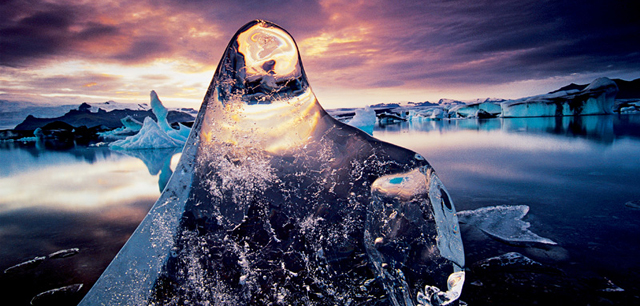sierraclub.org - sierra magazine - march/april 2010 - explore


Explore | Jökulsárlón Lagoon, Vatnajökull National Park, Iceland

Breidamerkurjökull glacier's 2 percent annual rate of decline spawns bone-chilling vistas in the ever-growing Jökulsárlón Lagoon.
"I'm not perfect. I think more highly of snow and ice than love."
— Peter Hoeg,
Smilla's Sense of Snow
After motoring through a frozen labyrinth for 20 minutes, the captain cuts the engines and we bob in silence among drifting sculptures. It's quiet out here, except for the raspy squeak of arctic terns, the occasional splash of herring and harbor seal, and the ice itself, which moans. Clouds descend, shrouding the lagoon in a chilly fog, covering the summit of 6,952-foot Oraefajökull, Iceland's highest peak, and adding to the otherworldliness of the place.
This lake, called Jökulsárlón, did not exist 75 years ago, when the giant Breidamerkurjökull glacier began receding. Then the glacier reached within a few hundred yards of the ocean. Now it's almost five miles inland, its terminus spilling pieces of itself into the 650-foot-deep lake. The crystalline forms range in size from toasters to minivans. One reminds me of a giant pterodactyl skull, another of a horse pulling a carriage. But mostly they look like frozen fire, or spirits trying to escape from some cold, deep place below.
The shapes glow a ghostly blue. Centuries of compression--the ice here is between 500 and 1,000 years old--have squeezed away the bergs' reflective surfaces, allowing only higher-energy blue light waves to penetrate. I am wondering how the ice can last so long in a place that doesn't feel all that cold, when our guide hands me a bite-size chunk. I pop it into my mouth. The ice is flavorless and dense, the kind you find in cocktails at the best bars, and I suck on it all the way back to shore. — Bevin Wallace
Iceland Travel Information
Created in 2008 and covering approximately 12,000 square kilometers (12 percent of Iceland's land mass), Vatnajökull National Park is the world's newest and Europe's largest national park. The entrances to the park along the country's stark southern coast offer access to Jökulsárlón Lagoon as well as the basalt-columned Svartifoss waterfall and Svinafellsjökull, the glacier where Batman Begins was filmed. Along the four-hour drive from Reykjavik, there are waterfalls, gorges, fishing villages, and black-sand beaches, among other sights, so it's worth hiring a guide to drive you and point them out. Our guide, Erlingur Hjalmarsson, of Iceland Excursions/Gray Line Iceland, was a font of information and great company to boot.
We stayed in the Hotel Skatafell, about three miles outside the national park boundary. While the hotel itself is spartan, it affords great views of the glacier, and its restaurant-despite looking like an IHOP-served delicious, gorgeously prepared meals. If you're planning a trip to Iceland (and there's never been a better time to go-prices in the country have fallen, and Icelandair offers direct flights from New York and Minneapolis for around $500), the Icelandic Tourist Board's U.S.-based Web site offers travel tips and information.
Just a few interesting things about Iceland: In summer, there is near-24-hour daylight, which is something to keep in mind when planning-you can pack a lot of hiking, sightseeing, and shopping into one day-and looking for accommodations (i.e., dark window shades are a must). Icelandic people speak Old Norse, now called Icelandic, an ancient Scandinavian language related to Danish and Swedish. It's basically the same language the Vikings spoke. In Iceland, people do not have surnames; their last name is usually their father's name followed either by "son" or "dottir." So if you're a guy named Sven whose dad is Jonas, your name is Sven Jonasson.
Iceland is about the same size as Ohio (40,000 square miles) but has a population of about 300,000. Iceland is literally bubbling with geothermic activity, which supplies most of the country with free and clean heating — and lots of naturally heated outdoor swimming pools. --B.W.
Photo: Art Wolfe/www.artwolfe.com